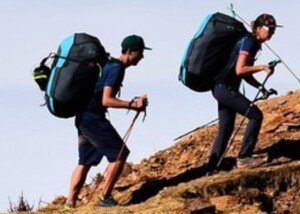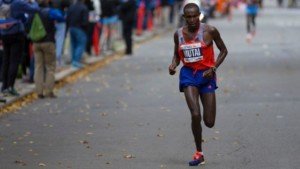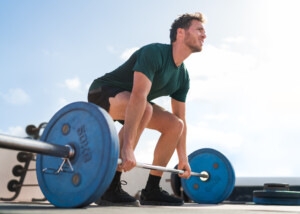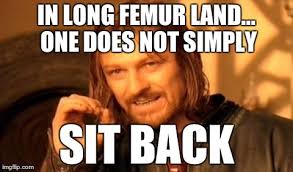
Does femur length really matter when it comes to hiking efficiency?
“Long femurs” refers to relative length of these bones to one’s overall height or leg length, and in the world of weightlifting, the issue of long femurs becomes relevant when these bones are longer than one’s torso.
A person can stand only 5-5 and have long femurs. A person can be 6-2 and have short femurs, meaning, for their height or leg length, their thighs are pretty short — they have an endless shin bone.
Long femurs are a biomechanical disadvantage in the barbell squat exercise, but an advantage in cycling due to torque (measure of force on a rotational object).
Short femurs are a big advantage for squatting, but a disadvantage in cycling.
So what about hiking?
Hiking includes descents. For hiking, long femurs come out ahead of short thighs, and remember, this is all relative to one’s overall height.
So don’t assume that every tall person has long femurs and every short athlete has stubby thighs.
Geoffrey Mutai is an elite marathon runner who has long femurs relative to his shins and overall height:

I have long femurs and stand 5-8. I finally figured out why I seem to be the only person in a group hike who can effortlessly and quickly ambulate down a talus slope.
I’ve always thought it was related to my years of playing volleyball (lots of “getting low” and “staying low”). I now think that long femurs have something to do with this.
To prevent falling on a talus slope (or any hill while descending), the hiker needs to get their center of gravity as close to the slope as possible.
This is why a dachshund has an easier time ambulating down a steep hill jutting with rocks than does a greyhound.
Long femurs also conserve energy when the hiker ascends, and I’ll explain why in a moment.
Hiking down a steep hill and especially talus slope should be done while in at least a half-squat position.
A hiker with short femurs can drop their center of gravity only so much before unnatural hip flexibility is required to sink even lower.
To understand all this, visualize hikers with wildly exaggerated body proportions.
Let’s say that Polly has one-foot long femurs and three-foot long shins. Sally has the opposite: three-foot long femurs and one-foot long shins. Both women are the same height.
Imagine Polly carefully making her way down a talus slope, sinking her hips down as much as possible. She’s still far above the ground, what with those towering shins.
Her torso/back is upright, which is good. But her center of gravity is not very low. She is prone to being off-kilter, like the greyhound.
Furthermore, it takes more energy to create long strides down the slope, as her foot is extended way out ahead of her knee, and she must then thrust her hip forward to complete the stride, whether it’s a sideways stride or three-quarters frontal (which is how one should descend talus, by the way; never descend facing fully forward).
With long femurs, Sally can sink her center of gravity really low.
This is not the same as a conventional barbell squat, because efficiently descending on talus requires the knees and feet to be wide apart and pointed out for optimal control, thereby shortening the distance between knee and hip, allowing for a more upright torso position.
In fact, for maximal control over talus, the hiker’s legs should be very wide, descending sumo style; the sumo stance allows the hiker with long femurs to be upright.
But even if at times, the feet are closer together, making the hiker with long femurs lean forward, the forward lean is okay because there isn’t a barbell across the back!
Sally’s center of gravity, like a daschund, is close to the talus. If she steps on a loose rock and starts falling, she won’t have as far to fall as will Polly, whose hips, torso, arms and head are further up, even though the hikers are the same height.
Long femurs enable Sally to complete long strides without thrusting her hips towards the stepping foot.
Imagine her descending, hips close to the ground because she is more horizontally displaced due to the long femurs.
I will admit that hip flexibility plays a role here. If a hiker has stiff hips, they’ll be inefficient at descending in a squat, regardless of femur length.
All talus descents should be done in a squat, with feet placed wide, regardless of femur length.
The closer your center of gravity is to the slope, the less likely you’ll fall, and if you do fall, you’ll have less distance to fall.
When ascending, Sally’s long femurs will have an advantage in that she won’t have to execute as much hip flexion as will Polly.
Polly can still get the job done quite well if she’s physically fit, but from a biomechanical standpoint, Sally will use less energy because long femurs will allow her to climb with less range of motion (hip flexion).
Visualize their climbing profiles using exaggerated features again, and you’ll clearly see the biomechanics.
This is easier to visualize if you replace a hill with a staircase. Polly must lift her foot up higher to get it on the next step.
With long femurs, Sally doesn’t need to lift as high (less hip flexion, smaller range of motion, less energy expended). Plus, to push off from the step, Polly must use greater range of motion.


























